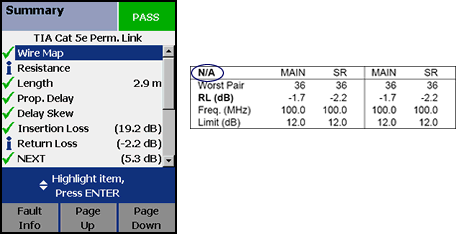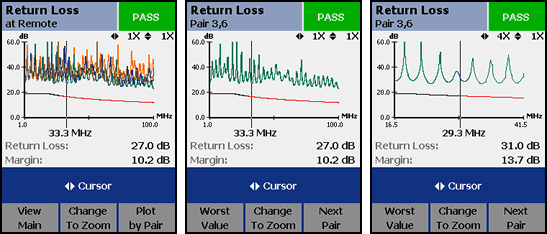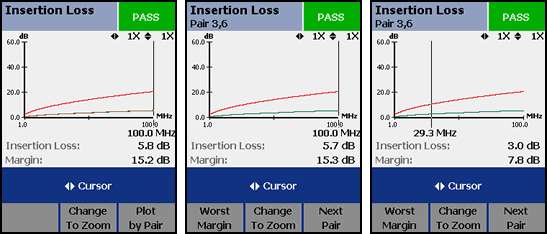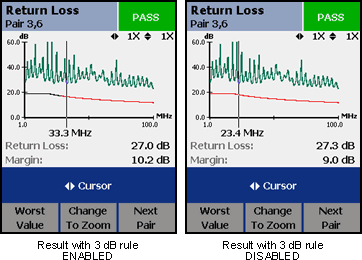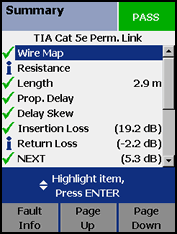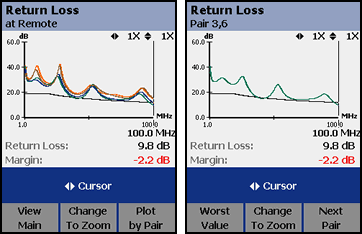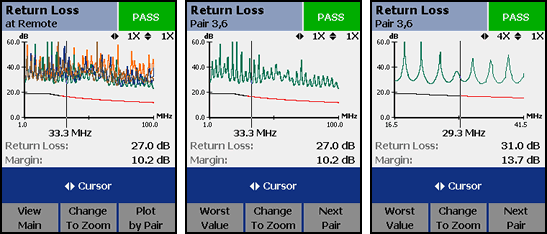When?the Insertion Loss is less than 3.0 dB at the frequency point where the measurement is made, then the Return Loss measurement is ignored and not evaluated against the selected Test Limit/Cabling Standard in the DTX CableAnalyzer.This is often referred to as the?3 dB rule.It applies to ALL cabling standards/test limits in the DTX CableAnalyzer.
On a short?link,
Concern is normally caused when the result has a negative margin.In this example we see the Return Loss margin was -2.2. A?negative margin is normally associated with a FAIL, but because the entire link never exceeded 3.0 dB Insertion Loss, it is not a FAIL.
Let’s review in detail how this works by looking at another example test result.
A TIA Cat 5e Perm.Link AUTOTEST was run on a 29.0 m installed link, giving the following result:
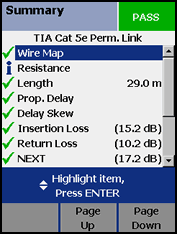
Looks normal – very nice margins.Let’s take a look at the Return Loss result in a little more detail:
You will observe that?the limit line has two colors, black and red.The cabling standards do not require the cable tester manufacturer to display where the?3 dB rule is implemented to the user, only that it is implemented.However, the DTX CableAnalyzer will indicate where the 3 dB rule has been implemented by changing the color of the limit line.If the?limit line is black, it?indicates that the Insertion Loss was less than 3.0 dB.If the?limit line is red, the Insertion Loss was 3.0 dB or greater.So for this Pair 3,6 the Return Loss?is not evaluated below 29.3 MHz. Let’s take a quick look at the Insertion Loss for Pair 3,6:
As you can see, the Insertion Loss reached 3.0 dB at 29.3 MHz, as previously indicated in the Return Loss Pair 3,6 graph above.
It’s an interesting rule, because if it were not in place, our margin for the above result would reduce from 10.2 dB to 9.0 dB:
As previously mentioned, if the link is particularly short, then the Insertion Loss may never reach 3.0 dB and the entire Return Loss?result is “ignored”.Let’s take a closer look at the first example where the test result was:
Looking at the worst case Return Loss result, we see the entire limit line is black, suggesting that the Insertion Loss for Pair?3,6 never reached 3.0 dB:
Looking at the Insertion Loss for Pair 3,6:
We see that the Insertion did indeed never reach 3.0 dB, so the entire measurement is not evaluated against the limit line (ignored) and recorded as “i” Information Only.If this result was downloaded to LinkWare Software, the report would show N/A against this measurement:
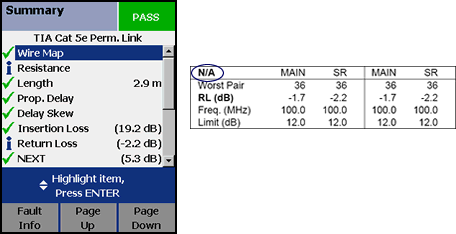
No further action is required by the installer.This is a valid standards compliant result.
